|
This is Moonlight's
first lure, the Floating bait. The slender wooden plug, finished in
luminous paint, is regarded as the first of the many
"pecker-head" plugs of the era. The yellow box is one of the
oldest. These boxes also turn up in maroon, white and blue-gray. The
floating bait was No. 1 in the Moonlight line. Many of them still glow
in the dark.
|
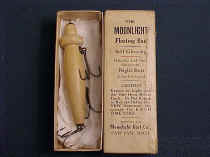 |
|
This is one of the
rarest Moonlights, the Trout Bob, made in 1911 and quickly discontinued.
Basically it's the flyrod version of the No. 1 Floating Bait shown
above. The color flyer inside offers tips on fishing the "Bob"
at night, when the big ones are lurking. This mint lure, box and paper
were found in Canada. The Trout Bob is one of my favorites.
|
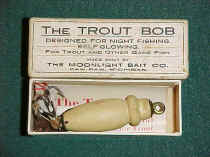 |
The
Paw Paw Fish Spear
dates to 1917. This short-lived simple plug came in an elegant picture
box with a nice litho of the lure, accurate in every detail. Fish Spear
boxes are almost always blue. Perhaps the Moonlight folks only made up a
batch or two of them. The Paw Paw Fish Spear has two line ties to adjust the
lure's action in the water. This lure was owned by a museum in Michigan
and sold - so they could buy some local pottery.
|
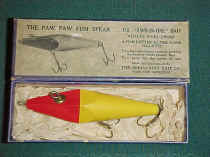 |
This
box - the only one known - clears up an enduring mystery. The No. 7 Paw
Paw Pearl Wobbler utilizes the distinct weight and bucktail found inside
the Fish Nipple. Til now, we knew that the No. 6 is the Zig-Zag of 1913,
and the No. 8 is the Bug of 1916. Now we know what the No. 7 is, and can
date it to 1914-15. Note the Moonlight hardware on the sinker.
This rare box turned up in a tackle box donated to a Goodwill store in
Grand Rapids, Mich., and was auctioned on Ebay - and adopted by yours
truly.
|
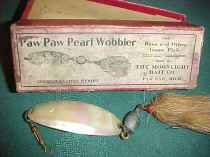 |
|
The Moonlight Zig-Zag
Bait was introduced in 1913, and this one is in its correct maroon intro
box. Early Moonlight Zig Zag lures were often painted with crude, runny "coach
paint" and lacked the finishes of the larger, more
sophisticated tackle makers. As you will see in subsequent
pictures, these guys did a lot of catching up a few years later!
|
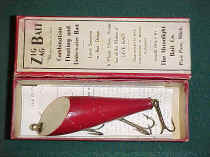 |
This
is one of the rarest of all Moonlight boxes: the maroon Midget Zig-Zag.
Although the lures are somewhat available, this is the only example of
this box that I'm aware of. The box is almost two inches shorter than
the regular Zig Zag carton shown above and the endflap is marked for a
yellow lure. My belief is that most Midget Zig Zags were simply sold in
standard Zig Zag boxes. Enjoy!
|
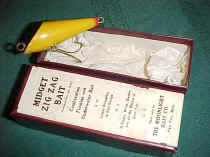 |
|
The Ladybug Wiggler is among
Moonlight's most beautiful lures. This rare picture box, with the
"Pat. Pending" stamp, contains a lure with no eye detail and
airbrushed legs, and of course the picture on the box matches the lure.
This is the oldest of two versions of the Ladybug Wiggler, dating
to 1915-16. The box was acquired from a visitor to this
website after it sat unappreciated in a tool shed for
decades. Like other Moonlight lures
of the Golden Age, it was around only for a few years.
|
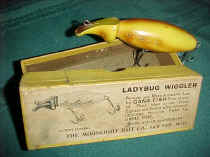 |
This
is the second - and more elaborate - version of the Ladybug Wiggler,
which no doubt took
a lot of work to produce. Note the addition of external milky glass eyes
and waxed string legs, which made this a more advanced model than the
one shown above. Also note this box has the 1917 patent date instead of
"Pat. Pending.". Red and yellow is a typical Moonlight finish.
This box is printed, while the above model is an applied paper label
style.
|
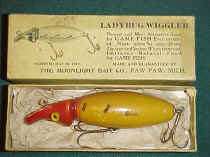 |
|
Guess when The Bug was
made? The wonderful box tells it all: "1916's Newest." The Bug
is another challenge to anyone who has ever used a lathe, and was around
only for a year or two. It is one of Moonlight's hardest to find
lures. This example turned up in a hunting and fishing cabin in Idaho,
along with a cache of other early baits!
|
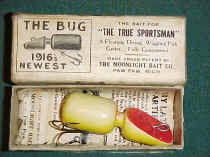 |
|
The Fish Nipple was a
simple rubber plug with an internal weight and horsehair out the
back. Introduced in 1911, the Fish Nipple is one of Moonlight's earliest
baits. The picture boxes may or may not be the first box made for these
odd lures; I've seen simple Fish Nipple boxes in block lettering that
could be even earlier. My ex-wife hated this lure.
|
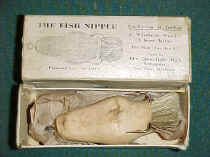 |
|
The Pikaroon was first made by
Silver Creek Novelty Works in Dowagiac, Michigan and also by Moonlight.
The Pikaroon is one of the most elegant baits ever made. Silver Creek
Novelty Works was rumored to have been formed by employees from Heddon.
This rare box is longer than the standard one, and note that the leaping
bass is facing left; typical boxes had the bass facing to the right!
|
 |
|
This is the yellow "Moonlight
Brand Minnows" used during the early 1920s when the company billed
itself as "Moonlight Bait and Novelty Works." The wonderful
lures inside are the later-version Ladybugs, so named for their intoxicatingly
beautiful blend of airbrushed colors.
|
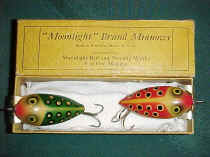 |
This is
a Moonlight Silver Creek Salesman Sample Case, circa 1920, complete with
all 33 lures including the Silver Creek Bass Eat-Us, Trout Eat-Us, Fly
Eat-Us, Pollywog and other Silver Creek Bait Company lures. The
set includes eight Silver Creek Novelty Works colors and the Pollywog
lures all have the hand painted "moustache" gill marks. This
is an exceptional and rare set of Silver Creek lures!
|
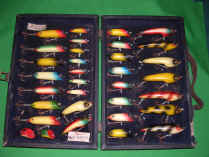 |
|
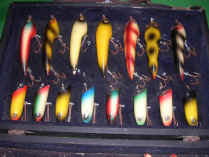
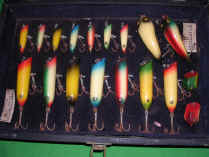
|
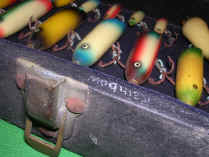 |